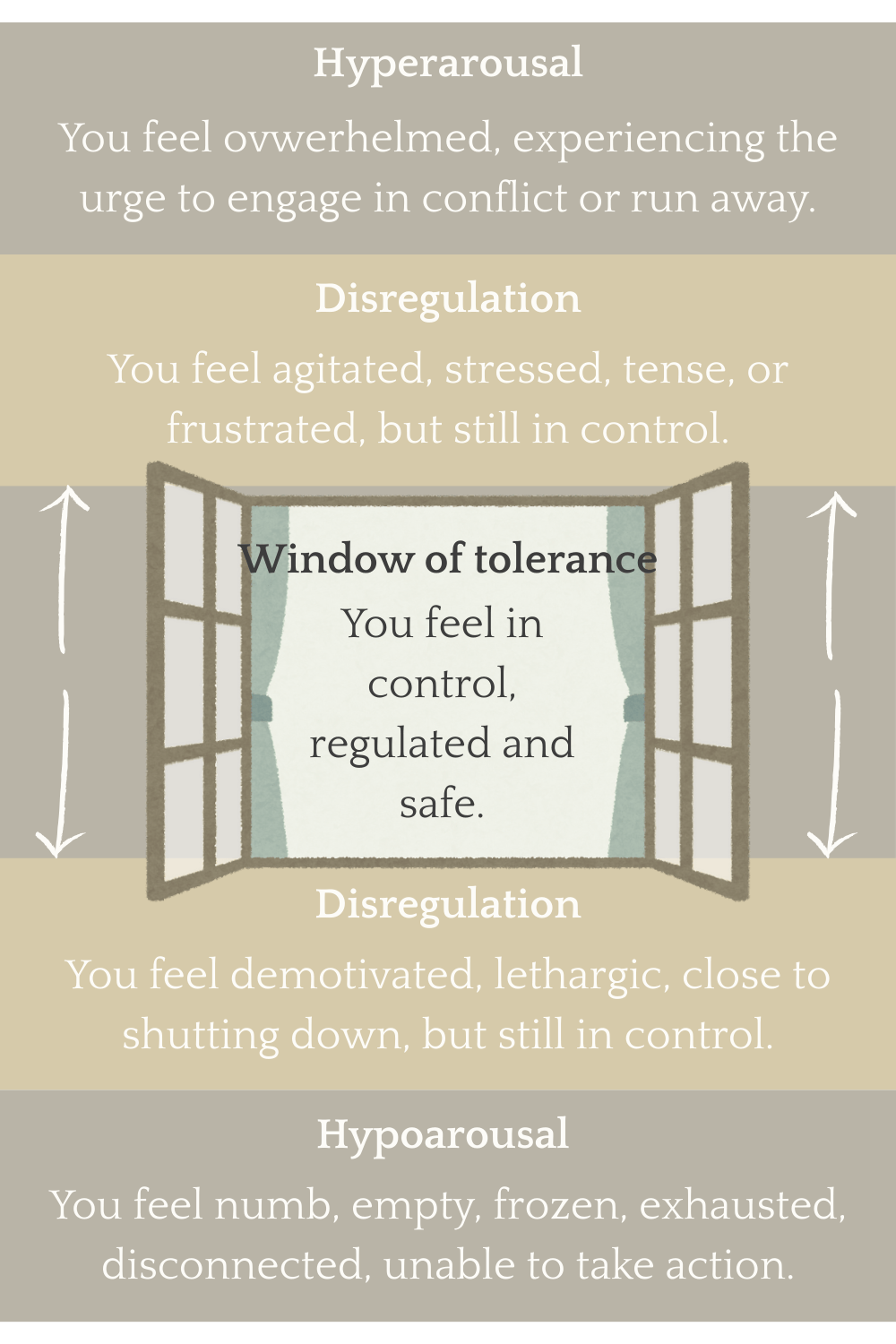What is the window of tolerance and how expanding it helps you embody your feminine essence

The Window of Tolerance is a concept used in polyvagal theory, also known as the science of safety. It helps us understand the impact of stress and chronic stress on our bodies and minds. The window of tolerance represents the biological zone where your nervous system feels safe enough to stay present with life. Inside this window, your body and nervous system have the capacity to regulate itself, and you feel grounded and able to manage challenges. You can meet intensity — whether it is stress, visibility, intimacy, or intense emotions — without collapsing into panic or complete shutdown. But when stress pushes you outside this window, your body and mind move into different states.
The window of tolerance is not fixed
Your window of tolerance is not something you are born with and stuck with forever. It is flexible. It can shrink when life feels overwhelming, and it can also expand when you and your nervous system receive the right kind of support.
When we go through trauma or chronic stress, our nervous system learns to be more reactive. Instead of staying steady inside the window, we are more easily pushed into overwhelm (hyperarousal) or shutdown (hypoarousal). This is especially true if the stress began early in life — neglect, abuse, or ongoing adversity in childhood can leave the nervous system more sensitive later on.
Even without trauma, everyday pressures can narrow the window too. Exhaustion, lack of sleep, hunger, or being under constant pressure can temporarily reduce your ability to stay regulated. And when your experiences or feelings are dismissed, minimised, or invalidated, it can chip away at your resilience, making it harder to feel safe in yourself and with others. None of this means you are broken. It simply means your system is doing its best to survive, and survival sometimes looks like staying hyper-alert or shutting down.
How can the window expand
The hopeful truth is that your window can grow. With care, practice, and the right kind of support, your nervous system can learn that it does not always have to react in survival mode. Gentle practices like mindfulness, conscious movement, grounding, and deep breathing can help anchor you in the present and calm the storm within. Somatic or body-based therapies also teach your body to experience and safely release sensations that once felt overwhelming.
Equally important are self-compassion and safe relationships. When someone sees you, accepts you, and helps you feel secure, your nervous system learns that it can soften. Hearing “It’s okay,” even from yourself, can soothe shame and create space to breathe again. Everyday choices matter too: rest, nourishing food, hydration, and gentle movement all strengthen your body’s baseline regulation.
How it feels when your window of tolerance widens
When your window expands, life feels different. Stress does not knock you over as quickly. You have more room to breathe, to think, to feel. You notice emotions flowing through you without flooding you. You can connect more deeply, take pleasure in simple things, and meet challenges with more resilience.
Expanding your window is not about being “calm” all the time. It is about having more space for all of life — the joys, the difficulties, and the intensity — without being pushed out of yourself. This is, in polyvagal theory, why we say that the goal is not to feel always calm, but to feel "safe enough". Safe enough means spending as much time as possible inside the window, because handling challenges inside the window feels more peaceful and requires less energy.
We often hear that to embody our feminine energy, we should learn to soften and receive more. The truth is, softening and receiving is way much easier when we are inside the window of tolerance than when our nervous system is deregulated. Feminine energy, which is a receptive energy, thrives in safety. Again, it is not about having a "perfect" nervous system or being calm all the time. It is about enhancing the safety of our baseline and striving for a sense of "safe enough". Our feminine energy will naturally flow and overflow when our bodies feel safe enough and no longer need to be stuck in fight-or-flight mode or in a state of complete shutdown.
This is why expanding our window of tolerance will not only benefit our health and satisfaction, but also our sensuality, how vibrant we feel, and our connection to our capacity to receive and create. If you want to expand your window of tolerance and bring more safety into your body, check out my free eBook, "Safe to flow", which is full of gentle and nourishing practices for your nervous system. Click on the picture below to access it:
The different states of your nervous system
Hyperarousal state:
When you are in a state of hyperarousal, life can feel overwhelming. Your nervous system is on high alert, and you may feel the urgent need to act: to fight, run, or escape. Hyperarousal is the body saying, “Danger! Respond now!” While it can give bursts of energy, it also drains your body and keeps you disconnected from pleasure, intuition, and calm presence. When you are in a state of hyperarousal, it often feels like your mind and body are racing ahead of you. Thoughts speed up and become restless, your muscles tighten, and your heart may pound as your breath turns shallow or fast. You might notice a constant edge of impatience or agitation, feeling easily startled, quick to frustration, or anxious, as though something urgent is about to happen.
Upper disregulation state:
In this zone, you feel tense or frustrated, but still in some control. You notice your agitation or stress, but you can hold it for a while without completely losing your grounding. This is a warning zone: your nervous system is nudging you that your window of tolerance is being challenged, and self-care or regulation tools may be needed to return to balance. In upper dysregulation, you may feel irritated, pressured, or mentally restless, as if your mind can’t quite settle. Your body feels tight and uncomfortable, and everything around you seems urgent, demanding immediate attention.
Inside the window:
This is the sweet spot where your body and mind feel safe, embodied, and present. This is where feminine essence thrives. You can stay embodied, connected, safe, and sensual, navigating life’s intensity with awareness and creativity. When you are inside your window of tolerance, you feel calm, grounded, and flexible. Emotions move through you without overwhelming you, allowing you to respond with thoughtfulness, feel pleasure, connect deeply, and notice that your body is at ease — your heart steady, your muscles soft and free.
Lower disregulation state:
Here, you may feel tired or unmotivated, but you have not fully shut down. You still have some capacity to act, even if it feels difficult. This zone signals that your nervous system needs rest and support. It is not a complete collapse yet, but it is becoming increasingly difficult to focus, be creative, and feel hopeful. In lower dysregulation, you may feel heavy and slowed down, with low energy, slight numbness, or lethargy. There is often a growing urge to withdraw or lie down, as though solitude would bring relief, while still holding just enough awareness to stay engaged with your surroundings.
Hypoarousal state:
In hypoarousal, your nervous system has retreated. You feel frozen, empty, disconnected, or exhausted. Hypoarousal is the body’s protective mode. It helps us survive extreme stress, but if prolonged, it blocks pleasure, creativity, embodiment, and our ability to move forward and act. In hypoarousal, you may feel a deep sense of numbness, heaviness, or exhaustion that makes even simple actions difficult. It can feel as though you are detached from your body and emotions, moving through life without the energy or connection to engage fully.
Articles you might also like:
What Is the witch wound? A nervous system perspective on appeasement
What is the polyvagal theory in a nutshell?
The neurobiology of feeling safe
FAQ: Window of Tolerance
-
What is the window of tolerance?
The window of tolerance is the biological zone where your nervous system feels safe enough to stay present with life, regulate emotions, and respond to stress without becoming overwhelmed or shutting down.
-
What happens when I go outside my window of tolerance?
When stress pushes you outside your window, your nervous system shifts into different states: hyperarousal (overwhelmed, anxious, agitated) or hypoarousal (numb, detached, exhausted), making it harder to think, act, or feel safe.
-
Can the window of tolerance change over time?
Yes. Your window is not fixed—it can shrink due to trauma, chronic stress, or ongoing pressures, and it can expand with self-care, supportive relationships, mindfulness, and body-based therapies.
-
How can I expand my window of tolerance?
Practices that help expand your window include mindfulness, grounding exercises, conscious movement, body-based therapies, compassionate self-talk, trauma-informed therapy, rest, and nourishing daily routines.
-
How does a broader window of tolerance feel?
When your window expands, you feel more present, emotionally flexible, and grounded. Emotions flow without overwhelming you; you can respond thoughtfully, connect deeply, enjoy pleasure, and meet life’s challenges with resilience.
-
Why is the window of tolerance essential for feminine energy?
Feminine energy thrives in safety and receptivity. When your nervous system is regulated within the window of tolerance, it’s easier to soften, receive, feel pleasure, and express your creativity and sensuality.



